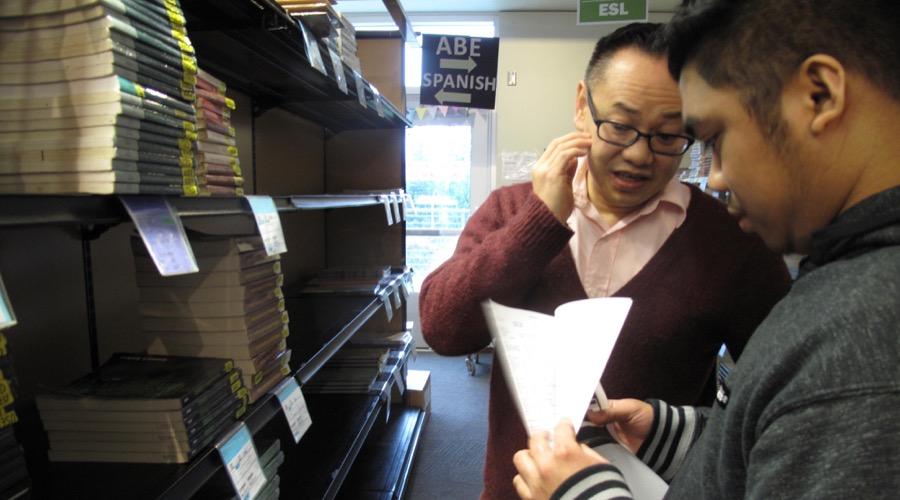Ekk Sisavatdy, left, helps an incoming freshman at Highline College in Burien, Washington, as part of a program that assists Asian American and Pacific Islander students.
Between three jobs and a full academic course schedule, University of Washington senior Sam Le is always on the go. He also plans to graduate on time this June. But that wasn’t the case when he was a freshman and nearly flunked out.
“I was taking hard classes early on and I was commuting really far,” Le said. “I thought I could manage it, but I couldn’t.”
Le was living with his parents far from campus because he didn’t want to waste the money they made paying for the dorms, he said. He felt overwhelmed, but didn’t think his problems compared to what his parents took on, arriving as refugees with nothing.
“I really took that to heart, that I can handle this if they could handle it. But they never told me that they had a community behind them with their entire family, their extended family, so I felt really isolated,” Le said. “I thought I’m supposed to do this all on my own.”
Poverty, isolation, and the pressure to excel are problems some Asian American students face. But statistics — and the model minority myth that Asian American students get perfect grades and go to Ivy League universities —can hide those problems by treating Asian Americans as a monolith. A study conducted in Washington state found that students with Cambodian, Hmong and Laotian heritage, among others with Southeast Asian roots, earned bachelor’s degrees at a lower rate than the national average.
That's what makes efforts in and around Seattle — to bring those challenges out of the shadows — stand out.
Ekk Sisavatdy runs a program at Highline College, a community college south of Seattle, that advises Asian American and Pacific Islander students. At the school's bookstore, Sisavatdy meets an incoming freshman of Filipino descent who recently got a GED diploma and shows him how to note the ISBN number on the back of a Spanish textbook to find it at a discount online.
Sisavatdy works one-on-one with students and also runs an annual college fair, in collaboration with a network of local advocates, that encourages students to apply for higher ed.
One common hurdle is a mindset in some Southeast Asian communities that prioritizes getting a job above a degree, Sisavatdy said. “When you’re able to work, you do work, and you find work to help and bring back to support the family,” he said. “That’s been very successful to many of our communities; you’ve got two three working folks in a household supporting one another.”
As a result, some students don’t see college in their future. For those who do, being less aware of financial aid deadlines, and not having family experienced with the process, can create snags. One missed deadline can derail everything. “They’re too late for their funding, so they have to wait. So what do they do? They get a job,” Sisavatdy said.
And higher education never happens.
Related: How Trump's rhetoric could cost colleges billions in lost tuition revenue
Sisavatdy says his life didn't fit the stereotype that Asian Americans breeze through school. “Because I’m more than just Asian American and others’ perception of what an Asian American is,” he said. “I’m Lao American. I’m a refugee. I’ve got eight siblings. I’ve got a mom that works night and day, hardly seeing her children.”
The model minority myth hides Jessica Do’s struggles too. She’s a freshman at the University of Washington, and the first in her family to go to college. The Vietnam War stopped her parents’ education because they arrived in the US with high school diplomas and didn’t have the time or the money to go to college in America, said Do, who came to the US when she was 9.
“It was a really, really tough transition, because I didn’t speak any English and then I was kind of thrown into the American school system, immediately,” she said.
Now in college, Do is interning with the Southeast Asian Education Coalition. “I think it’s my moral and civic duty to do what I can to give back and just try and make the system better for people who don’t have the same opportunities as myself,” she said.
Senior Sam Le said he knows how the mentoring can pay off, because that’s what has kept him in university. “I actually want to go to school now, like pursue something, and I have a community of friends to see that through and support me,” Le said.
Now he gives back the same way, helping other Asian American students and showing their campus, and the rest of the world, a more nuanced view of Asian American student life.
